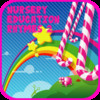NURSERY EDUCATION RHYMES 2
Detailed App Info:
Application Description
A wide variety of traditional nursery rhymes, fingerplays, and songs can be found in NURSERY EDUCATION RHYMES 1. These videos are usually fairly short and focus on skills and concepts such as animals, counting, getting dressed, and body parts. These videos also often contain rhyming words.
When you sing nursery rhymes to your children, you may be telling the same poems and tales that, in some form, were told by firelight from parents to their children centuries ago, perhaps even as far back as the Middle Ages. Determining the origins of these famous tales before they were written down is impossible, but many have made guesses about their early roots. “Ring Around the Rosy” may refer to the swollen cysts that afflicted the sick during the Black Death. You might be recalling an ancient Welsh king in “Old King Cole” who drowned in a swamp 1700 years ago, and in “Little Miss Muffet” the daughter of a bug expert in Shakespearean England, or a queen beheaded for her Catholic faith in “Mary Mary Quite Contrary.” These stories have undergone so many changes over the centuries that these meanings –if they did originate in these long-ago dark circumstances –are mostly obscured.
“Many of these songs were not originally for children,” says Kay Vandergrift, Professor Emerita of Children’s Literature at Rutgers University. Most of these songs were part of an oral-based society that relayed news, spread coded rumors about authority figures, and worked out its moral dilemmas (for kids and adults) in rhyme and song. And existing nonsense rhymes that were part of this oral tradition could be used or adapted to make references to current events. It was in the nineteenth century, when Victorian society sentimentalized childhood and romanticized “quaint” times from the past, that most nursery rhymes were written down and presented as for children only.
How are these poems—inhabited by kings, queens and peasants of a rural past predating electricity, television and computers—still relevant to twenty-first-century kids and parents? If we are so far removed from the world that hatched these rhymes, why should we still read them? Some of the reasons people sang nursery rhymes to each other in the past remain good reasons to do so today. Here are four main reasons nursery rhymes can be beneficial for kids:
When you sing nursery rhymes to your children, you may be telling the same poems and tales that, in some form, were told by firelight from parents to their children centuries ago, perhaps even as far back as the Middle Ages. Determining the origins of these famous tales before they were written down is impossible, but many have made guesses about their early roots. “Ring Around the Rosy” may refer to the swollen cysts that afflicted the sick during the Black Death. You might be recalling an ancient Welsh king in “Old King Cole” who drowned in a swamp 1700 years ago, and in “Little Miss Muffet” the daughter of a bug expert in Shakespearean England, or a queen beheaded for her Catholic faith in “Mary Mary Quite Contrary.” These stories have undergone so many changes over the centuries that these meanings –if they did originate in these long-ago dark circumstances –are mostly obscured.
“Many of these songs were not originally for children,” says Kay Vandergrift, Professor Emerita of Children’s Literature at Rutgers University. Most of these songs were part of an oral-based society that relayed news, spread coded rumors about authority figures, and worked out its moral dilemmas (for kids and adults) in rhyme and song. And existing nonsense rhymes that were part of this oral tradition could be used or adapted to make references to current events. It was in the nineteenth century, when Victorian society sentimentalized childhood and romanticized “quaint” times from the past, that most nursery rhymes were written down and presented as for children only.
How are these poems—inhabited by kings, queens and peasants of a rural past predating electricity, television and computers—still relevant to twenty-first-century kids and parents? If we are so far removed from the world that hatched these rhymes, why should we still read them? Some of the reasons people sang nursery rhymes to each other in the past remain good reasons to do so today. Here are four main reasons nursery rhymes can be beneficial for kids:
Requirements
Your mobile device must have at least 26.77 MB of space to download and install NURSERY EDUCATION RHYMES 2 app. NURSERY EDUCATION RHYMES 2 is available on iTunes for $0.00
If you have any problems with installation or in-app purchase, found bugs, questions, comments about this application, you can visit the official website of Lesley Chin at https://www.facebook.com/groups/295939790564649/.
Copyright © Thomas Barik





